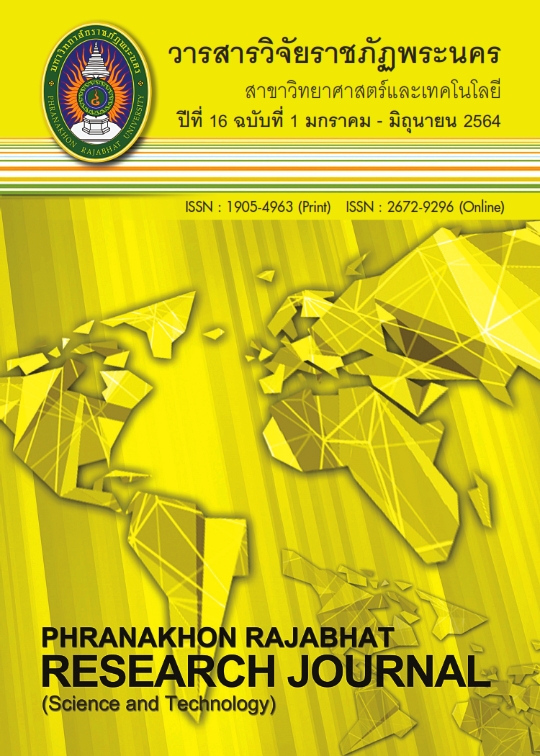THE EFFECT OF GENDER AND PERSONALITY DIFFERENCES IN YOUNG ADULTS ON THE EMOTIONAL AROUSAL OF THAI TEXTS AND PICTURES: EVENT-RELATED POTENTIAL STUDY
Keywords:
Emotional Arousal, Thai Text, Picture, Event-related PotentialAbstract
According to the previous research, receiving various types of emotional stimuli contributes to changes in human brain function. Therefore, the purpose of this study is to design experimental
tasks for young adults to look at arousing Thai texts and pictures which can potentially stimulate
emotional arousal while looking at Thai texts and pictures. The participants were chosen from 80
students at Burapha University in the academic year 2017. The instruments used in this research
consist of the experimental activity of looking at Thai texts and pictures which can potentially
stimulate emotional arousal and brainwave recorder to collect corresponding brain wave data
(P100, N200, N400, and P600). The data were analyzed by Two-way ANOVA. The research results
show that, while looking at Thai texts and pictures that arouse emotion in calmness characteristics,
there are differences in the emotional amplitude of P100, N200 and N400 in brainwaves among male and female young adults. In excitement characteristics, male and female young adults were
characterized by amplitude differences in brain waves N200, N400 and P600. With regards to open
and average personality, it was found that calmness characteristic amplitude differs in waves N200,
and excitement was characterized by amplitude differences in waves N200, N400 and P600. The
findings of this research indicate that Thai texts and pictures that arouse emotion lead to varying
effects to human brain based on gender and personality.
References
Edmond, W. A., & Kennedy, T. D. (2017). An Applied Reference Guide to Research Designs: Quantitative, Qualitative, and Mixed Methods. (2nd Edition). Los Angeles: Sage Publication.
Faul, F., Erdfelder, E., Buchner, A., & Albert-Georg, L. (2009). Statistical power analyses using G*Power 3.1: Tests for correlation and regression analyses. Behavior Research Methods, 41(4), 1149-1160.
Feinstein, J. S., Adolphs, R., Damasio, A., & Tranel, D. (2011). The human amygdala and the induction
and experience of fear. Current Biology, 21(1), 34-38.
Lee, S. H., Kim, E. Y., Kim, S., & Bae, S.-M. (2010). Event-related potential patterns and gender effects underlying facial affect processing in schizophrenia patients. Neuroscience Research, 67(2), 172-180.
Luo, Q.L., Wang, H.L., Dzhelyova, M., Huang, P. & Mo, L. (2016). Effect of affective personality
information on face processing: evidence from ERPs. Front Psychol, 31(7), 810.
Machajdik, J., & Hanbury, A. (2010). Affective image classification using features inspired by psychology and art theory. Sidney: ACM Multimedia.
Mendoza-Halliday, D., Torres, S., & Martinez-Trujillo, J. C. (2014). Sharp emergence of featureselective sustained activity along the dorsal visual pathway. Nature Neuroscience, 17(9), 1255-1262.
Mochizuki, A. A., & Kirino, E. (2008). Effects of coordination exercises on brain activation: A functional
MRI study. International Journal of Sport and Health Science, 6(1), 98-104.
Nilbu-nga, C. (2018). Functional Neuroanatomy. (3rd Edition). Bankok: Chulalongkorn Printing House.
(in Thai)
Petit, G., Kornreich, C., Maurage, P., Noël, X., Letesson, C., Verbanck, P., & Campanella, S. (2012).
Early attentional modulation by alcohol-related cues in young binge drinkers: An event-related potentials study. Clinical Neurophysiology, 123(5), 925-936.
Revelle, W., & Scherer, K. R. (2009). Personality and emotion. Oxford companion to emotion and the affective sciences.
Russell, J. A., & Mehrabian, A. (1977). Evidence for a three-factor theory of emotions. Journal of Research in Personality, 11(3), 273-294.
Shiota, M. N., & Kalat, J. W. (2012). Emotion. New York: Wadsworth.
Sripornngam, T., Chadcham, S., & Sudhasani, S. (2015). Development of the Thai Affective Picture Bank System. Research Methodology & Cognitive Science, 13(2), 57-70. (in Thai)
Storbeck, J., & Clore, G. L. (2007). On the Interdependence of Cognition and Emotion. Cognition and Emotion, 21(6), 1212-1237.
Sukchum. R., Chadcham, S., & Wongupparaj, P. (2018). Development of the Affective Norms for Thai Texts (THAI-ANT) Bank System. Research Methodology & Cognitive Science, 16(2), 145-160. (in Thai)
Whittle, S., Yücel, M., Yap, M. B., & Allen, N. B. (2011). Sex differences in the neural correlates of emotion: Evidence from neuroimaging. Biological Psychology, 87(3), 319-333.
Usrey, W. M., & Alitto, H. J. (2015). Visual Functions of the Thalamus. Annual review of vision Science, 1, 351–371.
Downloads
Published
Issue
Section
License
โปรดกรอกเอกสารและลงนาม "หนังสือรับรองให้ตีพิมพ์บทความในวารสารวิจัยมหาวิทยาลัยราชภัฏพระนคร สาขาวิทยาศาสตร์และเทคโนโลยี" ก่อนการตีพิมพ์




